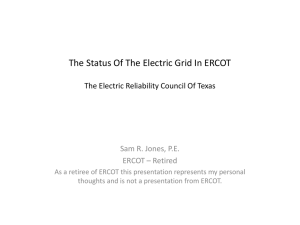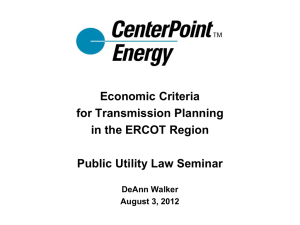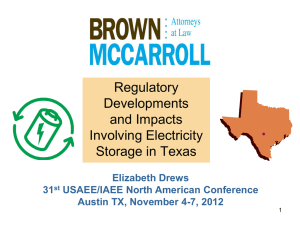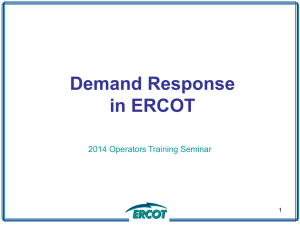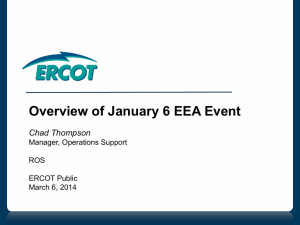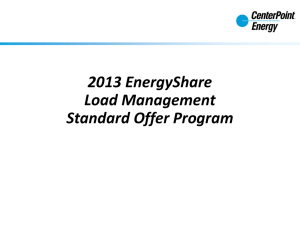Results from the 2013 Survey of LSEs to Obtain Retail DR and
advertisement
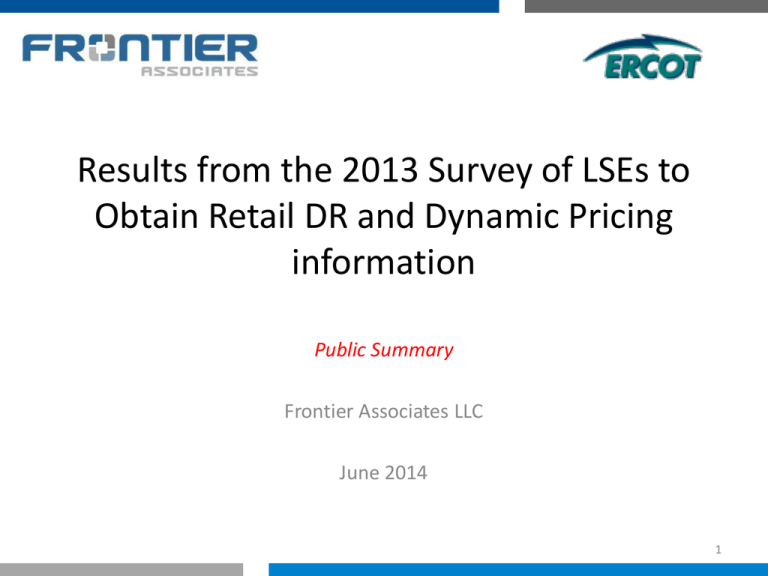
Results from the 2013 Survey of LSEs to Obtain Retail DR and Dynamic Pricing information Public Summary Frontier Associates LLC June 2014 1 Background PUC Subst. Rule §25.505(e)(5): Load serving entities (LSEs) shall provide ERCOT with complete information on load response capabilities that are self-arranged or pursuant to bilateral agreements between LSEs and their customers. ERCOT sent an electronic survey to all LSEs in June-July of 2013 seeking customer counts on dynamic pricing/demand response contracts –‘Your response to the survey will allow ERCOT to gain a better understanding of the amount of responsive Load and numbers of retail energy consumers actively responding to Load reduction signals’ 2 Purpose of the project • It’s important to understand retail DR & price response • Impacts of retail demand response and price response on the long term load forecast • Advanced metering – Enablement of DR is an important element in the return on the AMI investment • Ability to track growth of these products is a key metric in measuring the success of the ERCOT retail market 3 Background The survey revealed the numbers of current customers in the ERCOT region subject to retail price response/demand response products, including: Time of Use pricing Critical Peak pricing/rebates Real-Time pricing Direct Load Control 4CP response • For REPs in the competitive market, the survey did not ask for the LSE’s estimates of the MWs of demand reduction or strike prices • ERCOT then worked with Load Serving Entities to develop a plan for collecting and analyzing data 4 Project path Phase 1 – Initial Survey – Results presented to market in Aug 2012 (RMS and DSWG) Phase 2 – Data collection – Collected ESIID information from REPs Summer 2013 – Additional survey used to collect events from REPS – Phone calls with NOIEs Phase 3 – Analysis – After data collection, evaluation of price elasticity and how it affects: • Load forecasting • Wholesale market price formation • Resource adequacy Phase 4 – Report to market 5 Evaluation Project • ERCOT worked with Frontier for analysis and reporting – Defined approach, data requirements for a subset of the categories – Report on findings and results including presentations to stakeholders – All data is anonymized and Frontier signed NDA • Using the information collected from the survey and customer usage information in ERCOT’s possession, our analysis sought to quantify the amount of demand reduction that ERCOT could expect from these various programs and products during various events (e.g., a potential 4CP event or a spike in wholesale market prices). 6 Summary Statistics Number of Programs Offered by REP Number of Programs Offered Number of REPS 1 10 Program Codes RTP Real Time Pricing BI Block & Index PR Peak Rebate 4CP Four Coincident Peak TOU Time of Use/Thermal Storage/Distributed Generation OLC Other Direct Load Control OTH Other Voluntary Demand Response Product 2 6 3 3 4 1 5 1 Unused Codes CPP Critical Peak Pricing FO Financial Option 7 Summary Statistics • 21 REPs submitted validated ESIIDs to ERCOT • 177,451 ESIIDs with validated submissions –18,385 were excluded from analysis • 1,780 ESIIDs became inactive/de-energized after June 15 and still not active • 2,214 ESIIDs became inactive/de-energized after June 15 and went to different REP • 956 ESIIDs became inactive/de-energized after June 15 and returned to same REP • 13,322 ESIIDs stayed and went to different REP –117,570 ESIIDs were reported on Time of Use pricing products • TOU products are incentives for long-term behavioral shifts rather than event-based demand response. Analysis of these products and premises is beyond the scope of this initial analysis and is deferred to a future project. –41,496 ESIIDs remained for analysis by Frontier 8 Summary Statistics Participating ininOnly One Program PremisesESIIDs participating a single program 4CP ESIID Count REP Count 10 3 BI 22,947 14 OLC 10,071 2 OTH PR 1,877 2 733 3 RTP 4,105 12 TOU 117,570 4 Total 157,313 21 Premises participating in multiple programs REP 4CP-OLC 1 2 3 4 5 Total BI-4CP BI-OLC PR-OLC PR-TOU PR-TOU-OLC RTP-BI TOU-OLC 28 2 4 19 3 267 2 23 3 267 158 158 31 31 2 2 13 1290 1,303 Total 28 9 19 469 1,292 1,817 9 Approach to Quantifying Changes in Demand Associated with DR Actions • Identify “events” (e.g., price spikes, days with a high probability of setting a CP, curtailment requests). • Historical baseline method: Look at load patterns for a set of customers on previous days and compare (after making appropriate adjustments) with the load shape on the day of the event. • Regression analysis: Estimate the average impacts of various events on consumption of the customer(s), while statistically controlling for the effects of other factors which might affect energy consumption (including the weather). • IMPORTANT NOTE: All data was anonymized with REP and NOIE identities masked by ERCOT prior to providing to Frontier. 10 Approach to Quantifying Changes in Demand Associated with DR Actions Program OLC - Other Load Control 4CP Data Source Method of Analysis 15-minute interval consumption data (anonymized) from 05/01/2013 to 10/15/2013 for each ESI ID in this type of program. Event information, as reported by two REPs operating larger programs (including start and stop times). Start date for participation in the program, as reported by REP, for over 10,000 ESI IDs. Aggregated IDR data for consumers served at transmission voltage for each regulated transmission and distribution utility (TDU) service area from 2001 to early 2014. Frontier’s evaluation was limited to use of aggregated (nonindividual) data. The ERCOT staff then conducted supplemental baseline analysis (using a different baseline approach) of individual accounts that showed evidence of demand reduction during a 4CP. Baseline analysis focused on events as reported by REPs. Impacts were calculated on a customer-specific basis, for each program. An historical baseline was constructed, same as the ERCOT ERS “Middle 8-of-10” methodology, and actual usage was compared against baseline usage to estimate demand response A probabilistic analysis (logistic regression) was conducted to identify the days most likely to have elicited a 4CP response, based on weather, time of day, and other factors. Baseline analysis focused on actual and potential 4CP days (summer weekday afternoons). Baselines excluded weekend days, holidays, prior CPs, and near-CPs. Additionally, a regression model quantified the response of the aggregate usage of the transmission voltage customers in each TDU service area to 4CPs and “near 4CPs,” while controlling for other factors. 11 Approach to Quantifying Changes in Demand Associated with DR Actions Program RTP (Real Time Pricing) and BI (Block & Index) PR (Peak Rebate) Data Source Anonymized data for 4,100 RTP customers and 23,000 BI customers (10/15/201110/15/2013), along with location-related information for each account. Wholesale price data. Start date for program, as reported by REP, for each ESI ID enrolled in this type of program. Weather data. 15-minute interval consumption data (anonymized) for each ESI ID in this type of program. Method of Analysis Regression baseline focused on pricing events, defined as LZ SPPs at three distinct price levels: o $300/MWh o $1,000/MWh o $3,000/MWh Additional models were estimated looking at single price spike levels (e.g., just $3,000MWh). An historical baseline was constructed, same as the ERCOT ERS “Middle 8-of-10” methodology, and actual usage was compared against baseline usage to estimate demand response. An historical baseline was constructed, same as the ERCOT ERS “Middle 8-of-10” methodology, and actual usage was compared against baseline usage to estimate demand response. 12 4CP Response: A Summary Estimated Average Demand Response During a 4CP in 2013 Total MW Demand Response from Energy Consumers Served at Transmission Voltage in Competitive Areas (regardless of their participation in formal programs) (1) Programs Implemented by NOIEs (2) Other Load Control Programs activated during a CP RTP and B&I Programs (incidental impacts during a CP) Rough Estimate of Other Response not otherwise accounted for (3) TOTAL 250 200 Small Small 50 500 Notes: (1) An historical baseline calculation yields an estimate of 251 MW. Regression analysis suggests a reduction of 201 MW on average over the past 5 years. (2) Based on a review of savings estimates reported by NOIEs. We have been unsuccessful in independently confirming these estimates. (3) This is a conservative estimate based on judgment, to account for response by industrials with IDRs served at a voltage other than transmission and industrials within NOIE service areas. • See Appendix for additional 4CP information. 13 Customer Segment Providing the 4CP Response 14 Energy Consumption (in kWh) by Transmission Voltage Customers on CP of June 27, 2013, Contrasted against Baseline Energy Zooming In. . . 15 Energy Consumption (in kWh) by Transmission Voltage Customers on CP of July 31st, 2013, Contrasted against Baseline Energy Zooming In. . . 16 Energy Consumption (in kWh) by Transmission Voltage Customers on CP of August 7th, 2013, Contrasted against Baseline Energy Zooming In. . . 17 Energy Consumption (in kWh) by Transmission Voltage Customers on CP of September 3rd, 2013, Contrasted against Baseline Energy Zooming In. . . 18 Distribution of the 4CP Response in 2013 by TDU Service Area 19 Load Control Programs • NOIE programs indicate a potential for demand reduction of well over 200 MW • Four REPs reported programs; two provided data • Demand response estimates from the REP programs are quite small in comparison to the NOIEs – Numerous self-initiated events were reported • Many were too short in duration to provide a meaningful database for analysis • Many involved only a small subset of total enrolled premises – Estimated event-specific demand response not reported publicly due to low number of participating REPs • Reported participation provides a benchmark for analyzing growth in this product type in future years 20 Peak Rebate Programs • These programs had fewer than 2,000 participants in areas opened to retail competition in 2013 • Participants are mainly residential energy consumers • It appears as though only one of the two REPs offering this type of program used it in 2013 – probably due to the low number of price spikes (see Appendix) • Estimated demand response not reported publicly due to low number of participating REPs 21 Response to a Price Spike Estimated Demand Response During a Spike in Wholesale Energy Prices in 2013 (1,2) (For a Load Zone Settlement Point Price above $3,000/MWh) Total MW RTP and B&I Programs Customers with IDR Meters Customers with AMS Meters Rough Estimate of Other Response not otherwise accounted for (3) Load Control Programs Implemented by NOIEs Peak Load Rebate Programs TOTAL 180 2 50 200 0.5 432.5 Notes: (1) There were very few price spikes in ERCOT in 2013 (see Appendix). Consequently, many programs were not activated and the estimates here do not reflect potential demand reduction. (2) Methodology: Regression analysis. (3) This is a conservative estimate based on judgment, to account for response by industrials with IDRs served at a voltage other than transmission and industrials within NOIE service areas. 22 Response to Price Spikes by Consumers with IDR Meters in Competitive Areas 200 180 160 MW Reduction 140 120 100 80 60 40 20 0 ERCOT Price of $300/MWh 90.24176264 Price of $1000/MWh 91.98121016 Price of $1000/MWh 180.4429643 23 Response to Price Spikes by Consumers with IDR Meters in Competitive Areas– Baseline Approach • Intervals with North Zone price higher than $3000/MWh are selected as price spikes. The ERCOT ERS “Middle 8-of-10” methodology was adopted. Events Date 2 3/3/2011 3 6/27/2011 4 8/1/2011 5 8/2/2011 6 8/3/2011 7 8/4/2011 8 8/5/2011 9 8/23/2011 10 8/24/2011 11 4/5/2013 12 9/3/2013 • # of customers in the program 292 374 380 380 380 380 380 382 383 1192 1531 MW Saving -3.0 0.9 -10.3 -0.5 10.3 30.2 7.5 -2.8 28.7 181.9 90.1 Note that Feb 2nd, 2011 price spike event was deleted due to overlapping ERCOT EEA and ERS deployment. 23 Observations • Yes, the demand side of ERCOT’s market responds to price signals (e.g., spikes in wholesale prices and 4CP-based transmission prices). • Gaps in the data and the small number of price spikes in 2013 may have prevented us from detecting the full potential of these programs and pricing products in reducing demand during “events.” 24 Next Steps • 2014 data collection project – September 30, 2014 - snapshot by REPs for which ESI IDs are in programs – November 1, 2014 - file submission to ERCOT* – November 15, 2014 - error correction file submission to ERCOT • * pushed file submission back by 2 weeks to allow any error handling to be completed prior to Thanksgiving Holiday • REP should make all necessary corrections and re-send the full file to ERCOT. ERCOT will use the last file sent for data analysis. – November 15, 2014 – ERCOT will send Survey Monkey links to REPs to gather REP-specific event information • TOU Analysis – What are our expectations? – What can we accomplish without asking REPs for more data? 25 APPENDIX 26 Pricing Events -- June June 2013, North Load Zone 28 Pricing Events – July July 2013, North Load Zone 3000 29 Pricing Events – August Aug. 2013, North Load Zone 30 Pricing Events – September Sept. 2013, North Load Zone 31 4CP Background • The Four Coincident Peaks in ERCOT are the highest-Load 15-minute settlement intervals in each of the four summer months (June, July, August, September) • These intervals are the basis of various Transmission & Distribution (T&D) charges for much of the100%ERCOT Load – Non-Opt In Entities (Muni’s and 90% Co-ops), at the boundary meter 80% level – Retail Choice customers with 70% 60% peak demand ≥700 kW (Interval Data Recorder meter required) 50% 40% Chart represents percentages of Load at IE 1700 on Aug. 3, 2011, ERCOT’s all-time system peak “Large C&I” = IDR Required Combined, over 44% 30% of total ERCOT Load is subject to20% 4CP charges 10% Retail Choice Residential 37.3% Small Commercial 18.4% Retail choice load Large C&I 17.3% NOIE 27.1% 0% 1 31 How 4CP Works – Simple average of the metered load during ERCOT system monthly peak 15-minute intervals in four summer months -- June, July, August & September – Multiplied by the applicable prevailing TDSP Tariff, as approved by PUC – Is the basis for the monthly 4CP-based rates for the following calendar year 32 Historic 4CP Intervals (2003-2013) 16 Most common 4CP intervals are between 4:15 and 5:00 PM 14 12 10 8 6 4 2 0 15:30 15:45 16:00 16:15 16:30 16:45 14 17:00 12 August 13, 2007, is the outlier 10 8 6 Mondays and Fridays are the least likely 4CP days 4 2 0 Mon Tue Wed Thu Fri 33 Summer peak interval trends Daily ERCOT Peak Intervals June 2013 70,000 4CP @ IE 17:00 65,000 MW 60,000 55,000 50,000 45,000 40,000 0 2 4 6 8 10 12 14 16 18 20 22 24 26 28 30 Day of Month 34 Summer peak interval trends Daily ERCOT Peak Intervals July 2013 70,000 4CP @ IE 17:00 65,000 MW 60,000 55,000 50,000 45,000 40,000 0 2 4 6 8 10 12 14 16 18 20 22 24 26 28 30 Day of Month 35 Summer peak interval trends Daily ERCOT Peak Intervals August 2013 70,000 4CP @ IE 16:45 65,000 MW 60,000 55,000 50,000 45,000 40,000 0 2 4 6 8 10 12 14 16 18 20 22 24 26 28 30 Day of Month 36 Summer peak interval trends Daily ERCOT Peak Intervals September 2013 70,000 4CP @ IE 16:45 65,000 MW 60,000 55,000 50,000 45,000 40,000 0 2 4 6 8 10 12 14 16 18 20 22 24 26 28 30 Day of Month 37 The 4CP price signal • CREZ project activation = new 4CP incentives • >$5.2B in new facilities energized in 2013 – 5 times the average – These dollars will be recovered via 4CP TCOS rates over 30 years Date ‘Postage Stamp’ TCOS Rate (per 4CP kW) 4/16/2010 $26.05 4/8/2011 $28.10 4/12/2012 $29.36 3/23/2013 $30.95 11/30/2013 $40.86 3/19/2014 $41.08 } 58% increase in 4 years Source: ERCOT Transmission Projects Information Tracking (TPIT) Report, Nov. 2013 38


